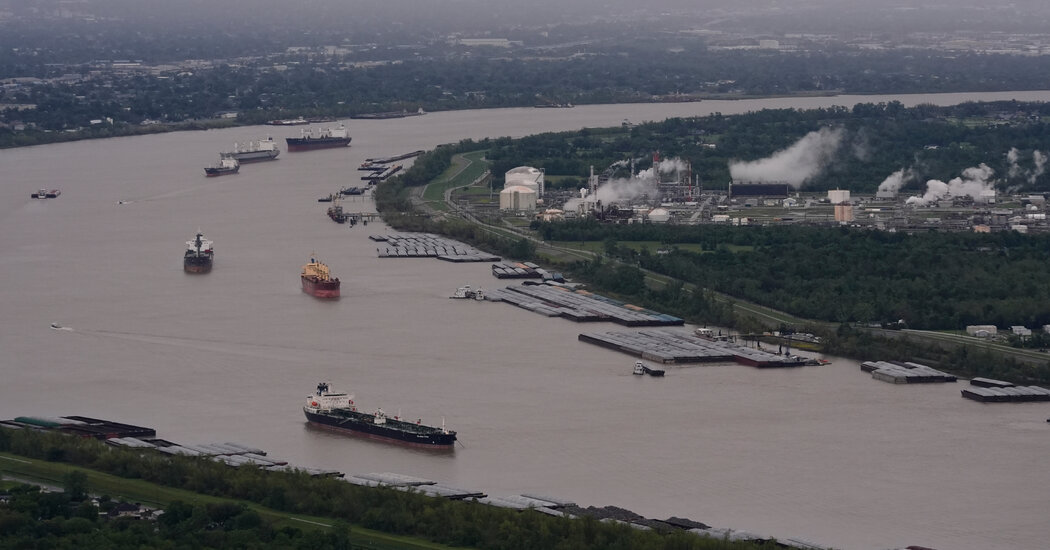In early April, a lethal rain of rain brought about a flood by the Midwest, as days of sturdy storms devastated a lot of the central a part of america. A month later the Mississippi River in New Orleans was eventually cracking This week, as a lot of the water from these storms ends its lengthy journey to the south.
The river regularly rises for weeks and reaches 16.7 toes on Thursday. That is barely under the flood stage of 17 toes and away from the report, however that is the best water stage in New Orleans since 2020 and comes towards the background of four -year land within the Mississippi River pool.
“It appears noticeably completely different than a 12 months in the past,” says Robert Florence, a co-owner of Historic tours of NOLAHe who takes a tour of the river every week in the past. “When the water is larger, it emphasizes on the sink, cross currents, vortices and vortices. Feels extra vibrant and highly effective.”
Mississippi’s dwls is the third largest on the planet.
The Mississippi River is advanced and big. Its important stem flows to 2350 miles from the principle waters of Lake Itanska in Minnesota to the Gulf of Mexico, touching 10 states and spreads to many others with its tributaries.
The water that goes down the river and arrives in New Orleans is the results of rain and snow which have occurred within the states as far-off as Pennsylvania, Minnesota, Montana, Colorado and Tennessee.
Within the case of water, which is being pressed in New Orleans in the mean time, it started as a falling rain 4 weeks in the past, primarily above the valleys of the Gorna Mississippi River and the valleys of the Ohio River. Between April 2 and 6, it turned roads into rivers and flooded communities In Arkansas, Missouri, Illinois, Indiana, Kentucky and Tennessee. Some locations registered over 15 inches.
Rain was a part of a extending storm system within the nation, which additionally generates thunderstorms and twister, though a lot of the harm comes from the ruthless rainfall, fueled by the moisture by the bay.
Small rivers within the above watershed historical levelsAnd I used to be again down. The flood cycle is longer on the channel and accepted Mississippi, which is fed by quite a few tributaries.
The rain in early April turned an outflow and flowed for days, on the prime of the decrease pool of the Mississippi River and its tributaries, together with Arkansas, white and pink rivers, and particularly Ohio. This may increasingly take weeks to throw away from Mississippi to the highest, and this water will ultimately journey down the river.
“That is the state of affairs we see now, the place in Kentucky, heavy rains have fallen in Kentucky in early April and it is going to be roughly 4 weeks earlier than peak launch to achieve New Orleans,” says Corey Consoir, an affiliate director of the River Analysis Heart at Louisiana.
As all this water was touring south, the river swelled with it, inflicting further floods in some areas and forward of roads and agricultural lands that have been just lately planted. About 250 miles north of New Orleans, Vixburg, Miss.I noticed the river rising to a big flood earlier this week, after which it stayed there for a number of days.
The river has been rigorously monitored for weeks.
It was recognized that the river would attain a peak in New Orleans this week. The Nationwide Meteorological Service envisages forecasts, and the US Military’s engineering constructing is carefully monitored because it operates the river water provide system of heaps, floods and reservoirs constructed to stop main flood disasters.
Generally the Military Corps will open the preparation and floods designed to divert the floods throughout excessive climate occasions. It didn’t open from the storms in April, nevertheless it approached.
This week, the company has performed checks at Bonnet Carre Spillway, 30 miles northwest of New Orleans, to make sure it’s prepared, if vital, to stop the flood. The distinction opens when the river flows into the bay at a velocity of 1.25 million cubic toes per second. However Matt Rowe, a hull spokesman within the New Orleans space, mentioned the circulation is anticipated to be ashamed of this stage.
“The entire occasion was very shut,” mentioned Mr. Rowe. “Within the earlier forecast, we have been supposed to exceed this set off, however it appears that evidently the circumstances are popping out a little bit smaller.”
The transfusion was in-built 1931 to take away the strain on the lever that protects New Orleans, deflecting as much as 250,000 cubic toes of contemporary water per second within the salt waters of Lake Pontchartrene. Since then it has been used 15 instances, 5 of them between 2016 and 2020.
“This isn’t probably the most water that has moved within the final decade, however it’s nonetheless plenty of water,” mentioned Mr. Rowe.

